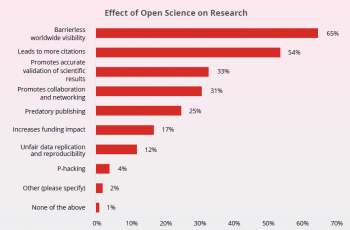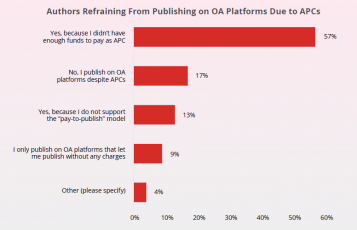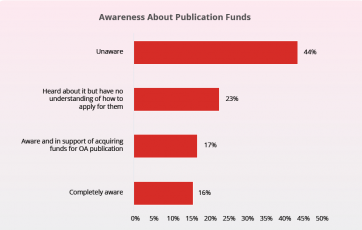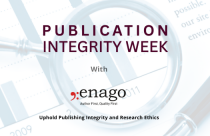Opening Doors to Academic Inclusivity: The significance of open access funding

Academia is an ever-evolving space where researchers strive to advance our understanding of the world and the exchange of knowledge has always been revered as a driving force for progress and innovation. However, access to this vast sea of information is often hindered by paywalls and restricted resources, creating a digital divide that hinders the growth of global academic communities. Emerging as a response to the high cost of accessing academic journals, which had traditionally been available only to those with institutional subscriptions or individual memberships, open access (OA) publishing refers to the practice of making academic research papers and other scholarly publications freely available to the public online.
The inception of OA publishing can be traced back to the Budapest Open Access Initiative (BOAI) in 2002, which called for the establishment of an alternative system for scholarly publishing that would remove barriers to access. This transformative movement, driven by the desire to break down these barriers, has become a beacon of hope for academic inclusivity. In this article, we’ll examine the importance of open access, delve into the obstacles it faces, and explore the pivotal role that open access funding plays in the quest for a more inclusive academic world.
 A Glimpse into Open Access
A Glimpse into Open Access
Open access isn’t merely a modern academic buzzword; it represents a fundamental shift in the way we share and access knowledge. Its importance resonates on multiple fronts:
Breaking Down Paywalls for Broader Accessibility
Traditional academic publishing, characterized by high subscription costs and pay-to-access models, often left many on the outside looking in. Access to research became a privilege, exclusive to the financially fortunate or those affiliated with well-funded institutions. This exclusivity left students, independent researchers, and individuals from resource-scarce backgrounds in the dark, unable to unlock the treasure trove of scholarly work.
Open access serves as a remedy to this inequity. It does so by dismantling the financial barriers, providing free access to research through online platforms. In this era, knowledge is no longer locked behind closed doors; it is freely available to anyone with an internet connection. This transformation signifies a seismic shift, where knowledge is liberated from the confines of ivory towers and becomes accessible to all, unleashing a world of ideas for exploration.
Global Reach and Influence
The influence of open access extends well beyond national boundaries. Research articles published in open access journals traverse the globe without hindrance. This means that a groundbreaking discovery by a researcher in Tokyo can seamlessly influence and inspire their counterparts in Tanzania. Open access isn’t merely a means of democratizing knowledge; it acts as a vehicle to extend its reach and influence, fostering international collaboration and propelling innovation to new heights.
The APC Dilemma: Unmasking the hidden challenge
Yet, amid the celebration of open access, a significant challenge remains hidden in plain sight — the Article Processing Charges (APCs). These charges, the fees associated with publishing research in OA journals, present a complex dilemma. While open access promises free access to knowledge, the financial burden of APCs often forces researchers to make a heart-wrenching decision — compromise on the accessibility of their work or grapple with the financial constraints posed by these charges.
The Role of Open Access in Global Academic Communities
Joint research endeavors hold immense potential, paving the way for accelerated progress and groundbreaking results within the academic sphere. Open access publishing serves as a crucial facilitator of these collaborations, offering a multitude of advantages that contribute to bridging the information and knowledge access gap.
Open access publishing represents a paradigm shift by removing the shackles of restricted access and reusability that often encumber traditional research dissemination. In the context of collaborative research, this aspect is invaluable. Furthermore, funders have recognized the pivotal role played by interdisciplinary research and provide comprehensive support for collaborative initiatives. These collaborations have even given birth to new terminologies, effectively encapsulating the essence of research spanning two or more distinct subjects. Open access actively encourages the sharing of negative results through preprints, a practice that enriches our understanding of the subject matter. Additionally, the utilization of data from prior research efforts proves to be instrumental in fostering collaborative research.
Open access publishing extends its influence to global proportions, making it possible for researchers to engage in collaborative endeavors that transcend geographical boundaries. A striking illustration of this transformative power is exemplified by the Human Genome Project, a monumental international research initiative. Open access played a pivotal role by liberating publications and data, transforming them into a formidable resource for research, education, and innovation.
Surveying the Impact of Open Access
In a recent survey conducted as part of Enago’s Research Risk Assessment initiative, the perspective of authors and researchers on open access and its funding mechanisms was illuminated. The survey, spanning multiple languages and involving over 390 respondents from 326 universities in 60 countries, aimed to explore the attitudes and understanding of funding opportunities within open access publishing.
Open Science’s Impact on Research
The survey results underscore the value of open science in advancing research. A striking 65% of the participants agree that open science provides unhindered global research visibility. Furthermore, 54% acknowledge its role in increasing citations, expanding the reach of research findings. About 33% emphasize how open science fosters precise validation of scientific outcomes, enhancing research rigor, and 31% see it as a catalyst for collaboration and networking. However, it’s worth noting that 25% express concerns about potential predatory publishing in the open science landscape.

Addressing Concerns and Challenges
Open science, while promising, has raised valid concerns. Some survey participants worry that it may disproportionately benefit financially well-off researchers, potentially disadvantaging those from low- or middle-income countries who struggle with APCs. Addressing these concerns is crucial to ensure equitable access to open science benefits.
The Impact of APCs on Publishing Choices
APCs play a vital role in open access publishing. Survey results indicate that 57% of respondents refrained from publishing in open access journals due to APC costs. However, 17% were willing to bear these costs, recognizing the advantages of open access. Interestingly, 13% prefer open access platforms without APCs, and 9% lack support for the APC model.

APC Affordability and Perception
A significant majority (80%) finds APCs expensive, impacting both publishing and research. High APCs may deter researchers from submitting their work to such journals, limiting knowledge dissemination. This also poses challenges for publishers attracting quality research. To address this issue, publishers must explore flexible pricing models, while researchers should seek alternative avenues to share their work without the burden of high APCs.
Awareness of Publication Funds
Surprisingly, 44% of participants were unaware of publication fee funding options. Among the remaining respondents, 23% knew of these opportunities but lacked knowledge about accessing them. This lack of awareness presents a substantial obstacle for researchers, potentially hindering their open access publishing efforts.

Funding for Open Access: A lifeline
Policymakers and organizations worldwide have recognized the transformative potential of OA. They understand that open access is not merely an ideology but a practical necessity in our increasingly globalized world. One such example is the White House policy, which directed federal agencies with significant research and development budgets to develop plans ensuring public access to the results of federally funded research. This policy’s implementation led to a greater emphasis on open access and inspired discussions about the importance of transparency in research dissemination.
These policies are not mere words on paper; they serve as a lifeline for researchers. They allocate funds to support publication fees, ensuring that financial constraints do not act as shackles hindering the dissemination of knowledge. The impact of these initiatives is both real and tangible, empowering researchers, regardless of their financial circumstances, to actively contribute to the discourse of academia.
However, navigating the complexities of securing funding for open access publication can indeed be a challenging and intricate task for researchers. It requires a comprehensive understanding of the available funding sources, your institution’s policies, and funder’s requirements. To assist researchers in this endeavor, we’ve prepared a valuable resource — Guide to Secure Funding for Open Access Publication: A researcher’s checklist, which aims to provide invaluable insights into how to fund open access publications in alignment with the institution and funder requirements.
A Brighter Horizon for Academic Inclusivity
In conclusion, open access isn’t just about online journals and digital articles; it’s about equity, inclusivity, and the democratization of knowledge. It’s about creating a world where a researcher’s potential isn’t stifled by financial constraints. It’s about nurturing a global community of scholars where ideas transcend borders.
Open access funding isn’t just an idealistic concept; it’s a practical step toward a more inclusive and accessible academic world. As policymakers and organizations rally behind OA, researchers worldwide stand to benefit. Together, we can unlock the doors to academic inclusivity, where knowledge knows no bounds, and innovation thrives through collaboration.
Frequently Asked Questions
Open access is a publishing model that provides free, unrestricted access to scholarly research and publications, making them available to the public without paywalls or subscription fees.
Open access is important because it promotes the widespread dissemination of knowledge, enhances global access to research, and accelerates the pace of scientific progress. It allows researchers, students, and the public to access and build upon the latest research findings.
Disadvantages of open access publishing can include the financial burden of Article Processing Charges (APCs) on authors, potential issues with predatory publishing, and concerns about the sustainability of open access journals.
The ease of publishing in open access journals can vary. While open access journals are generally more accessible, publication is subject to peer review and editorial standards, similar to traditional subscription-based journals. Researchers still need to meet the quality and relevance criteria set by the journals.









